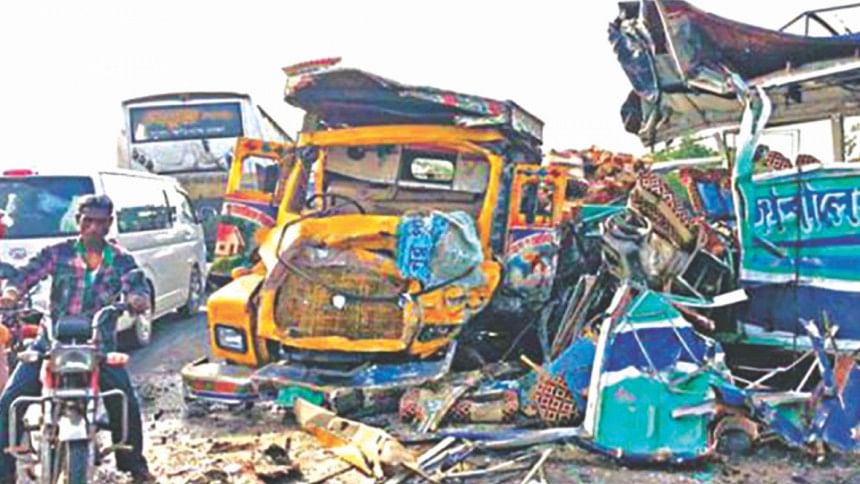Making our roads safer

The World Health Organization's (WHO) data shows that 1.25 million people are killed and as many as 50 million people are injured in road crashes every year. Road crash ranked as the 11th leading cause of death, accounting for 2.1 percent of all deaths globally. Around 90 percent of the 1.25 million deaths caused by road crashes each year occur in developing countries. Road injuries are the leading cause of death among people aged between 15 and 29, and the ninth leading cause of death overall, according to the WHO statistics.
The UN World Day of Remembrance for Road Traffic Victims, pursuant to General Assembly resolution 60/5, observed every third Sunday in November, is a major advocacy day for road traffic injury prevention. This year's theme—"reduce road fatalities AND serious injuries by 50 percent"—has been framed in line with the UN Decade of Action for Road Safety 2011–20 and has reaffirmed the importance of drawing urgent measures to reduce the prevalence of road crash.
The Chair of the UN Road Safety Collaboration, Dr Etienne Krug, in his official statement on World Day of Remembrance for Road Traffic Victims, said, "We once again turn our thoughts to the millions who have lost loved ones on the world's roads this year. Every day the media bring us news of tragic events, behind each of which are a grieving family and friends, whose lives are forever changed. It is indeed a time to remember and to acknowledge that much more must be done—and now—to avoid such tragic loss of life…The best way to honour the memory of those who have suffered on the world's roads would be for governments to fulfil the commitments they made at the start of the Decade of Action for Road Safety 2011–2020 before it is too late."
WHO statistics show that more than 90 percent of road traffic deaths occur in low- and middle-income countries, and road traffic injury death rates are highest in the African region. According to WHO, "even within high-income countries, people from lower socioeconomic backgrounds are more likely to be involved in road traffic crashes." People aged between 15 and 44 years account for 48 percent of global road traffic deaths. Males are more likely to be involved in road traffic crashes than females. About three quarters (73 percent) of all road traffic deaths occur among young males under the age of 25 who are almost three times as likely to be killed in a road crash as young females.
Speeding, impaired driving (due to alcohol/drugs/fatigue), not wearing seat belts or helmets, and texting are some of the factors that lead to road crash. WHO statistics also show that an increase of 1km/h in mean vehicle speed results in an increase of three percent in the incidence of crashes resulting in injury and an increase of four to five percent in the incidence of fatal crashes.
Unsafe road infrastructure has been found to be an important contributing factor to road crash and the design of roads has a considerable impact on safety. Ideally, roads should be designed keeping in mind the safety of all road users. This would mean ensuring that there are adequate facilities for pedestrians, cyclists, and motorcyclists. Footpaths, cycling lanes, safe crossing points, and other traffic calming measures are critical to reducing the risk of injury among road users.
Dr Md Shamsul Hoque, Professor, Department of Civil Engineering, Bangladesh University of Engineering and Technology, is a road safety expert. During his research, he found that many road crashes took place due to infrastructural issues rather than vehicular speed, etc.
A BRAC study shows that even though road crashes mostly happen on highways, the actual spots on these highways where the bulk of the crashes occur are bus stands (41 percent), road intersection points (17.8 percent) and marketplaces (28 percent). The study also found that majority of the road crashes occur in crowded spots or intersections rather than isolated stretches on highways—contrary to popular belief. This is a reminder that enforcement of traffic laws and vigilance of traffic police are the need of the hour.
Safe vehicles play a critical role in averting road crashes and reducing the likelihood of serious injury. Dr Md Shamsul Hoque in his research study shows that faulty design of vehicles alone contributed greatly to the increase in road crash fatalities. BRAC has taken into consideration a set of recommendations to enhance the capacity of Bangladesh Road Transport Authority (BRTA)—the lone institute in charge of ensuring fitness of vehicles and certifying their credentials.
The first one hour after a road crash—globally known as the "golden hour"—is crucial. This is when early medical care might prevent fatalities or dire consequences from an injury. Sadly, however, both private and public health service providers in South Asia, including Bangladesh, have historically been negligent about providing emergency medical services to road accident victims. Furthermore, Good Samaritans are usually fearful of legal consequences, harassment, etc.
Road crash fatalities are not just an inevitable concomitant of development; these fatalities can be prevented and minimised through judicious and timely action. WHO states, "Governments need to take action to address road safety in a holistic manner. This requires involvement of multiple sectors such as transport, police, health, education, and actions that address the safety of roads, vehicles, and road users. Effective interventions include designing safer infrastructure and incorporating road safety features into land-use and transport planning, improving the safety features of vehicles, improving post-crash care for victims of road crashes, setting and enforcing laws relating to key risks, and raising public awareness."
SDG 11.2 calls to "provide access to safe, affordable, accessible and sustainable transport systems for all, improving road safety, notably by expanding public transport, with special attention to the needs of those in vulnerable situations, women, children, persons with disabilities and older persons" by 2030. The aspiration set by the SDGs now requires the Bangladesh government to intensify its efforts in coordinating road safety actions—be it legislative reforms or ensuring effective enforcement of existing laws and policies.
Sadrul Hasan Mazumder is Programme Coordinator, Advocacy for Social Change, BRAC and Coordinator, Safe Road and Transport Alliance (SROTA). Email: [email protected]

 For all latest news, follow The Daily Star's Google News channel.
For all latest news, follow The Daily Star's Google News channel. 



Comments